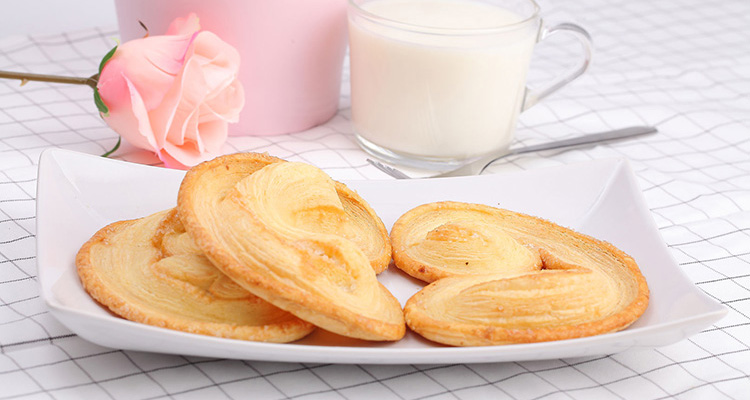Shanghai Butterfly Pastry: Classic Crispy Delight
Butterfly pastry, a refined Western dessert adapted in Shanghai, has become an iconic Hai‑pai pastry. Not born in the city but thoroughly embraced by Shanghai’s food culture, this sweet is named for its butterfly‑wing shape—dough folded, pressed, sliced, and baked into delicate, symmetrical layers.
1.Origin and History: A Western Treat Turned Shanghai Classic
The butterfly pastry traces its roots to Europe—likely France or Austria—and arrived in Shanghai in the late 19th or early 20th century as Western bakeries and restaurants opened in the treaty ports. Local bakers didn’t merely copy the recipe; they adapted it for local tastes. Sugar levels were adjusted to suit Shanghainese preferences, and techniques were refined to emphasize flaky layers. This transformation turned an imported pastry into a distinct Hai‑pai specialty that reflects Shanghai’s long history of cultural exchange.
2.Cultural Meaning: A Sweet Expression of Hai‑pai Spirit
In Shanghai’s diverse culinary scene, the butterfly pastry has a special place. It exemplifies the Hai‑pai spirit—openness, creativity, and fusion. Combining Western butteriness and shape with a sweeter, more delicate Shanghai palate, the pastry appears both in classic tea settings and trendy cafés. Tasting it connects visitors with the city’s blend of tradition and modernity.
3.Ingredients: Simple Elements, Exceptional Flavor
Shanghai butterfly pastry relies on a few high‑quality ingredients:
- Flour: A balance of high and low‑gluten flours gives the pastry a crisp exterior and a slightly resilient bite.
- Butter: Real butter is essential. Good butter melts and creates rich aroma and layered crispness; some long‑established bakeries even use imported butter for consistency.
- Sugar: The Shanghai style often sprinkles coarse white sugar on the surface, which partly caramelizes during baking, creating a crunchy, caramelized shell.
- Salt: A pinch of salt balances the sweetness and enhances the butter’s aroma.

4.How It’s Made: Building the Layered Puff
The signature flaky layers come from careful lamination:
- Dough: Mix flour, water, a little butter, and sugar into a smooth dough.
- Butter Block: Enclose a slab of butter in the dough to create a butter core.
- Folding and Rolling: Roll and fold repeatedly (the “lamination” or “turns”), chilling between turns to keep butter firm. This process creates hundreds of alternating dough and butter layers.
- Shaping and Slicing: After the final roll, sprinkle sugar, roll both sides toward the center into twin logs, chill until firm, then slice crosswise. Each slice reveals the butterfly‑like shape.
- Baking: High heat causes the butter to steam and puff the layers; sugar caramelizes into a golden, crisp finish.
5.Flavor and Texture: A Crispy, Buttery Harmony
A freshly baked butterfly pastry offers a golden sheen and a satisfying snap. It crumbles into fine flakes, releasing rich butter aroma and a mix of caramelized sugar sweetness. The contrast between crunchy sugar crystals and fragile, airy layers creates a balanced, not cloying, sweetness that invites a second bite.
6.How to Eat and Tasting Tips
- Classic Pairings: Traditionally enjoyed with Chinese teas—green tea or black tea—to balance sweetness. Modern pairings include espresso, latte, or milk tea.
- Best Time to Eat: Fresh from the oven is ideal. If buying packaged pastries, reheat briefly in an oven or air fryer to refresh crispness.
- Serving: Eat with your hands for the full sensory experience, or gently break one open to admire the layers before tasting.
7.Where to Find the Best Butterfly Pastry in Shanghai
To taste an authentic version, try:
- Old‑established bakeries: Famous hotel bakeries and century‑old Western pastry shops often still make classic butterfly pastries with traditional methods.
- Specialty bakeries: Small artisan bakeries may offer creative variations—almond, chocolate, or slightly different shapes—while keeping the flaky technique.
- Buying tips: Freshly baked items beat prepackaged ones. If buying as a gift, choose sealed packages and reheat before serving.
8.Simple Home Version: Make a Quick Butterfly Pastry
Try an easy home recipe if you want to recreate a Hai‑pai twist:
- Ingredients: store‑bought frozen puff pastry, melted butter, coarse sugar.
- Method: Thaw and roll puff pastry slightly, brush with melted butter, and sprinkle generously with coarse sugar. Roll both sides toward the center, wrap, and chill until firm. Slice into 1 cm pieces and place on a baking sheet.
- Bake: At 200°C (390°F) for 15–20 minutes until golden and crisp. This shortcut won’t produce the exact many‑layer texture of professional lamination but yields a delicious, accessible result.

Conclusion: Let a Butterfly Pastry Brighten Your Shanghai Visit
More than a pastry, the butterfly pastry is a small, sweet key to understanding Shanghai—its openness, craftsmanship, and appetite for reinvention. When in Shanghai, stop at a bakery smelling of butter, buy a warm butterfly pastry, and let the crisp, buttery layers become a memorable part of your China trip. Start planning your food adventure and find the most beautiful “butterfly” in the city.


